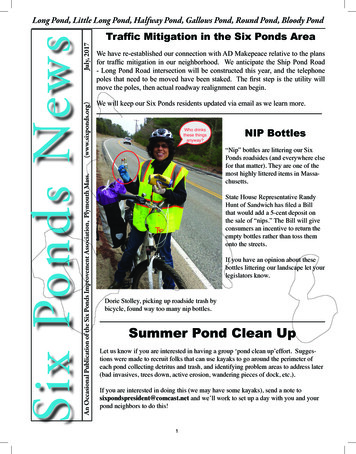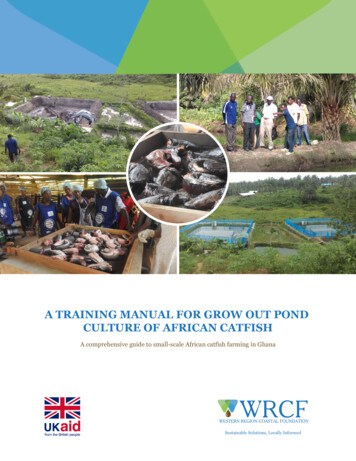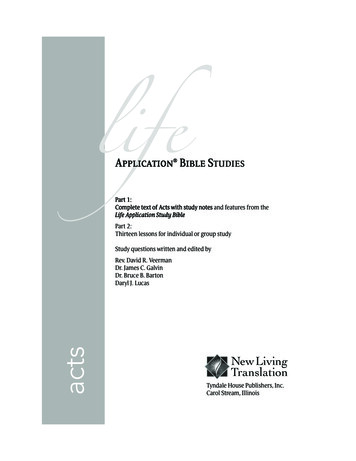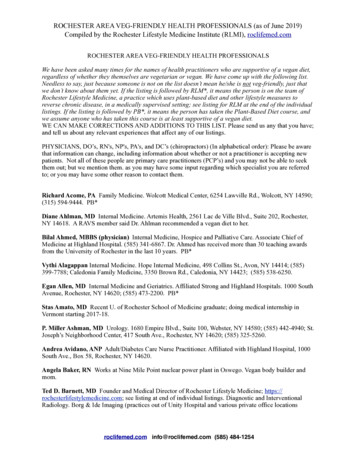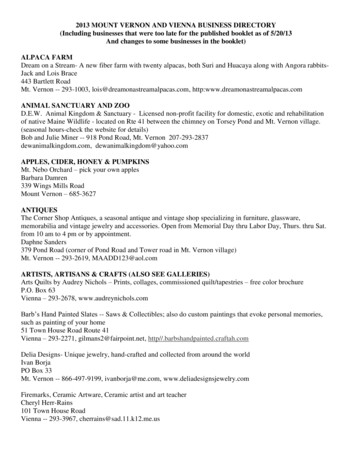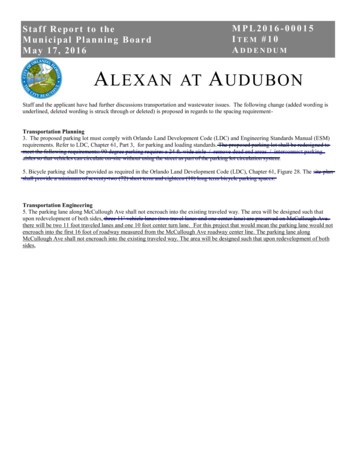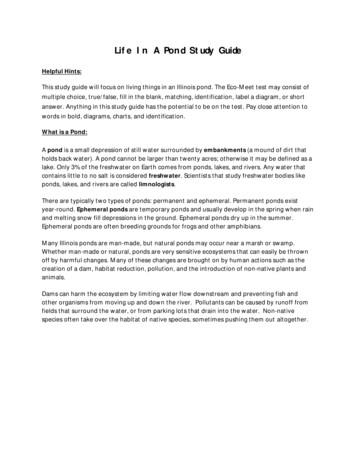
Transcription
Life In A Pond Study GuideHelpful Hints:This study guide will focus on living things in an Illinois pond. The Eco-Meet test may consist ofmultiple choice, true/false, fill in the blank, matching, identification, label a diagram, or shortanswer. Anything in this study guide has the potential to be on the test. Pay close attention towords in bold, diagrams, charts, and identification.What is a Pond:A pond is a small depression of still water surrounded by embankments (a mound of dirt thatholds back water). A pond cannot be larger than twenty acres; otherwise it may be defined as alake. Only 3% of the freshwater on Earth comes from ponds, lakes, and rivers. Any water thatcontains little to no salt is considered freshwater. Scientists that study freshwater bodies likeponds, lakes, and rivers are called limnologists.There are typically two types of ponds: permanent and ephemeral. Permanent ponds existyear-round. Ephemeral ponds are temporary ponds and usually develop in the spring when rainand melting snow fill depressions in the ground. Ephemeral ponds dry up in the summer.Ephemeral ponds are often breeding grounds for frogs and other amphibians.Many Illinois ponds are man-made, but natural ponds may occur near a marsh or swamp.Whether man-made or natural, ponds are very sensitive ecosystems that can easily be thrownoff by harmful changes. Many of these changes are brought on by human actions such as thecreation of a dam, habitat reduction, pollution, and the introduction of non-native plants andanimals.Dams can harm the ecosystem by limiting water flow downstream and preventing fish andother organisms from moving up and down the river. Pollutants can be caused by runoff fromfields that surround the water, or from parking lots that drain into the water. Non-nativespecies often take over the habitat of native species, sometimes pushing them out altogether.
Layers of the Pond:The water in a pond is layered according to temperature, oxygen and life. The topmost zonenear the shore of a pond is the littoral zone. This zone is the warmest since it is shallow and canabsorb more of the sun’s heat. It sustains a fairly diverse community, which may include algae ,aquatic plants, snails, clams, insects, crustaceans, fish, and amphibians. The vegetation andanimals living in the littoral zone are food for other creatures such as turtles, snakes, and ducks.The near-surface open water surrounded by the littoral zone is the limnetic zone. The limneticzone is well-lighted (like the littoral zone) and is dominated by both phytoplankton andzooplankton and freshwater fish. Plankton are small organisms that play a crucial role in thefood chain.Plankton have short life spans—when they die, they fall into the deep part of the pond, theprofundal zone. This zone is much colder and denser than the other two. Little light penetratesall the way through the profundal zone.The Benthic Zone consists of mud and decomposing organic material. This area is below thelevel of light and contains little to no oxygen.During the spring and fall, there is a mixing of the top and bottom layers, usually due to winds.This mixing circulates oxygen throughout the pond.
Plant LifeIf a pond is to be a successful habitat for wildlife, it must havenative plants growing in it. They provide food, oxygen andshelter for the animals.Algae are photosynthetic organisms. Photosynthesis is theability for a plant to convert energy from the sun into its ownchemical energy (food). Many algae are single celled,Figure 1: That green stuff the geese are swimminghowever some species are multicellular. A common pondthrough is algae on top of the water. When algaeblanke the surface of the pond like this it can depletealga is green alga; the green hairy growth found on a pond.oxygen in the water.Algae release oxygen into the water as they manufacturefood. However, when algae becomes overabundant thedecaying algae deplete oxygen levels. So during the summer, when conditions for growing algaeare best, oxygen levels in the water may decrease, causing"summerkill" for aquatic plants and animalsFloating Plants are not attached to the bottom of the pond. Floating plantscome in sizes from very small (duckweed) to over a foot in diameter (waterhyacinth). Most have roots that hang in the water from the floating greenportions.Figure 3: Bullfrog sitting induckweed.Figure 2: Water Hyacinth – notice roots are not attached tothe bottom of the pond but hang just below the surfaceSubmerged Plants are plants that arerooted in the bottom of the pond with most of the plant below thewater’s surface. Submerged plants have very soft stems, which iswhy they do not usually rise above the water’s surface. Illinoispondweed is an example of a submerged plant. This native planthas long, narrow submersed leaves and produces a thick spike ofgreenish flowers.Figure 4: Illinois PondweedEmergent Plants are rooted plants, often along the shoreline, thatare above the surface of the water. The stems of emergent plantsare somewhat stiff or firm. Cattails, or Typha is a type of emergent plant.Cattails are tall reedy marsh plants with brown furry fruiting spikes.Figure 5: Cattail
Is it a healthy pond?Macroinvertebrates are organisms that are large (macro) enough to be seen with the nakedeye and lack a backbone (invertebrate). These animals live in the water for all or part of theirlives, so their survival is related to water quality. Aquatic macroinvertebrates are goodindicators of water quality because: They are affected by the physical, chemical, and biological conditions of the pond.They may show the physical impacts of pollution. Some are very intolerant of pollution,so the lack of particular species could be a pollution indicator.The following diagram represents just a sampling of common macroinvertebrates in Illinoisponds. These labels reflect the creatures’ sensitivity to water pollution. For example, lack ofmayfly nymphs may be an indicator that the water quality is poor because they are verysensitive to water pollution.
Please be able to identify and possibly answer questions regarding these macroinvertebrates.VERY SENSITIVE TO POND WATER QUALITYAdult IdentificationLarvae IdentificationA Caddisfly Adult: Only feeds on liquids, since it does nothave well-developed mouthparts.Is active only at night (nocturnal) .Is found on land.A Caddisfly Larva: A Mayfly Adult: Does not have a functioning mouthbecause it only lives about one day. Justlong enough to reproduce and die.Has 3 long tails.Is found on land.Constructs cases out of sand grains,fragments of wood, and other naturalmaterials and weeves it together withsilk. The silk is produced through aspecial gland called the 'labium'.Is found in the water and overwinters inponds in larval form.A Mayfly Larva: Spends most of its life as larvae in thewater.Feeds on algae.Almost simultaneously all the larvaeemerge out of the water together.
SENSITIVE TO POND WATER QUALITYAdult IdentificationLarvae IdentificationA Dragonfly Adult: Is often found near water and usuallyremains within a few miles of where ithatched.Eats other small insects, primarilymosquitoes. A Dragonfly is carnivorousin both larval and adult stages.Is found on land.Fun Fact: A different species of dragonfly livedover 250 million years ago (before thedinosaurs) and had a wingspan of overthree feet!A Dragonfly Larva: Is called a naiad. It lives in the water fortwo to three years and uses gills tobreathe.Crawls out of the water and sheds itsskin when it is ready to enter the adultstage.Is found in water.Eats using its labium. The larvecontracts its muscles and pushes outthe labium and harpoons prey with thetwo sharp "fangs.”
SENSITIVE TO POND WATER QUALITYA Water Strider Larva: Hatches from eggs on rocks or aquaticvegetation.Undergoes “incompletemetamorphosis,” where the nymphresembles the adult (only smaller).A Water Strider Adult: Can slide along the surface of the waterby distributing its weight evenly on itslong legs.Is carnivorous and use itspiercing mouth parts to suck the juicesfrom other insects.Use its front legs to detectmovement or ripples in the water, andthen use its front legs to grab prey.Is found on top of the water.A Whirlygig Beetle Adult: Has two pairs of compond eyes. Oneabove water and one below.Is found in water.A Whirlygig Beetle Larva: Is carnivorous just like its adult form.Is found in water.
TOLERANT OF POND WATER QUALITYAdult IdentificationFun Fact: Scientists have trainedflatworms to find water in amaze. When flatworms arecut in half, the new halveslearn faster than theoriginal.A Flatworm: Has eyes that detect light.Is found in the water.-A Mussel: Has two shells connected by a hinge-like ligament.Is found in pond water but is more often found in rivers.Can siphon water, filtering bacteria, algae, and particles,which make them one of the few animals that improveswater quality.Is found in water.
VERY TOLERANT OF POND WATER QUALITYAdult IdentificationLarvae IdentificationA Water Boatman Larva: Hatches from an egg that wasdeposited on the stem of anunderwater plant.Undergoes “incompletemetamorphosis,” where thenymph resembles the adult(only smaller).A Water Boatman Adult: Spits on plants to dissolve them so it can suck inthe juices with a tube-like mouth part.Has oar-shaped hind legs to swim and carry its airsupply under their shell.Is found in water.A Backswimmer Larva: A Backswimmer Adult: Can give a stinging painful bite.Swims upside down.Is found in water.Fun Fact: Male backswimmers make a soundunder water, much like a cricket, to attractfemale backswimmers.Resembles an adult when ithatches from the egg.Lacks functional wings.Spends several months in thelarval stage.
VERY TOLERANT OF POND WATER QUALITYA Diving Beetle Larva:A Diving Beetle Adult: Traps air between its wings and body prolongingits time under water.Is found in the water.A Mosquito Adult: Requires blood (protein) for egg production(Females ONLY).Is found on land. Is also known as a water tiger.Has large pinchers to grabprey.Is found in the water.A Mosquito Larva: Hatches from an egg on thesurface of fresh or stagnantwater.Lives in the water from 4 to 14days depending on watertemperature and is called a"wiggler."Is found in water.
Larger Pond Animals:(Reptiles)Aquatic Turtles:The Common Snapping Turtle has a long, bumpyneck, mud-colored body, and usually has analgae-covered shell. Its ability to camouflageallows it to blend in on the pond bottom - perfectfor striking at a fish.Red Eared Sliders are the most common aquatic petturtle and are given their name for the red stripe on eachside of their head. The "slider" part of their name comesfrom their ability to quickly slide off rocks and logs intothe water. As adults, sliders eat insects, small fish, plantsand berries. Red Eared Sliders must eat their food in thewater because they are unable to make saliva to swallow.The skin of an adult Painted Turtle has a yellow stripeddesign that makes it appear as though it has been handpainted. Painted Turtles can survive without oxygen at 37 Ffor up to five months. Painted Turtles bask in the sun tokeep their body temperature around at least 65 F so theirstomach can digest efficiently. Painted Turtles areomnivorous, eating insects, worms, tadpoles, small fish,crustaceans, and aquatic vegetation. Like almost all semiaquatic turtles, Painted Turtles cannot ingest food unlesstheir mouths are fully underwater.
(Crustaceans)Crayfish:Crayfish are a relative of lobsters. They arenocturnal, doing most of their hunting atnight. The head has a sharp snout, and theeyes are on movable stalks. They have tenlegs; the front two have large claws called"Chellae." Crayfish are omnivorous, so theyeat both plants and animals. They are alsoscavengers and will eat dead things, as longas they are relatively fresh. How big theyget, and how fast they grow, depends onmany factors such as water quality,temperature, and how much food is available. When a crayfish is threatened, it will escape byflipping its abdomen and swimming backwards or it will use its large claws as a last resort.(Mammals)MuskratMuskrats get their common name from their resemblance tostocky rats and from the musky odor produced by their scentglands. Muskrats weigh 2 to 4 pounds and reach lengths of18 to 25 inches. 8 to 11 inches of this is their sparsely hairedtail. Their coat color is generally dark brown, but individualscan range from black to almost white. Muskrats havepartially webbed hind feet that function as paddles andmuch smaller front feet used primarily for digging. Muskratsdig up plants for food and for building their den. In doing sothey create open water for ducks, geese, shorebirds, andother wildlife.
(Birds)WaterfowlWaterfowl have two primary habitat requirements. First, they need a body of water on whichto land, escape, rest, and roost. Second, they must have a suitable open feeding area thatprovides a place to land, has good visibility of the surrounding territory, and has abundant grassand other vegetation for feeding. Mallards are primarily filter feeders and will consume almostanything edible. Geese eat a variety of terrestrial grasses. All species will come on land to feed,typically in the morning and late afternoon.Canada Geese mate for life and both care for and aggressively protecttheir young. They are often seen moving in pairs or flocks. Flying flocksoften assume a V formation. There about 10 species of geese in Illinois,but the Canada goose (see left) is probably the most common.Male Mallard Ducks have a dark, iridescentgreen head, bright yellow bill, and gray body. Females and juveniles aremottled brown with orange-and-brown bills. Mallards are “dabblingducks”—they feed in the water by tipping forward and grazing onunderwater plants. There are about 30 species of duck found in Illinois.The Mallard Duck is probably the most common (see right).The Great Blue Heron stands tall at 50 inches with blue-gray plumage. Itoften stands motionless as it scans for prey, or it wades belly deep withlong, deliberate steps. They may move slowly, but Great Blue Herons canstrike like lightning to grab a fish.
(Fish)Bluegills prefer clear lakes and ponds with adequate aquatic vegetation to avoid predation byother fish. Bluegills eat mostly aquatic insects and larvae. The male bluegill builds and watchesover the nest. The average size of a bluegill is 5”.Yellow Bullhead Catfish can tolerate shallow ponds and variable oxygen levels. While bullheadswill feed all day, they forage more actively at night. A Yellow Bullhead Catfish measures 8” onaverage.
Green Sunfish are about 4.5” long and have a high tolerance for poor water quality. They canbe found in very muddy bodies of water. Green sunfish mainly feed on aquatic insects, but willalso eat small fish and crayfish thanks to their large mouth.Largemouth Bass are top predators in many ponds, measuring 10”. They swallow their preywhole and will eat a wide variety of food.
White Crappie diets consist mostly of smaller fish (e.g., minnows), but they will also feed onaquatic insects, larvae, worms, and crustaceans. It is impossible to distinguish a male from afemale. White crappies measure 9” in length.The Common Carp was initially introduced in Illinois from Europe in 1886. Carp prefer pondswith a lot of organic matter. Carp thrive in ponds with poorer water quality. Carp like to eat uproots and shoots of young plants but also forage on aquatic insects, crustaceans, and smallmollusks. Carp are large freshwater fish, measuring 16” on average.
(Amphibians)Frogs:The Bullfrog is olive or brown with green on thehead. The bullfrog is the largest frog in NorthAmerica, reaching a length of 8”. A bullfrog has avery large tympanic membrane, the flat, oval circlebehind its eyes. The tympanic membrane is ahearing organ in frogs and toads. A bullfrog call hasbeen described as a deep bass “gr-rum” or “jug-orum,” and can be heard for more than a quartermile on a quiet night.Southern Cricket Frogs are very small frogs, nolarger than an inch, and are considered the smallestin the state. Their coloration varies widely andincludes greys, greens, and browns in blotchingpatterns. They get their name from their cricket-likecall.The back of a Southern Leopard Frog is usuallycovered with irregular dark brown spots betweenlight colored areas. Other distinguishingcharacteristics include a light line along its upperjaw and light-colored raised lines on their backs. ASouthern Leopard Frog call is similar to rubbing afinger over an inflated balloon.Please visit: ction main.lookup andlook up the 3 frog calls and be prepared to know them on the test.
This study guide will focus on living things in an Illinois pond. The Eco-Meet test may consist of multiple choice, true/false, fill in the blank, matching, identification, label a diagram, or short . The topmost zone near the shore of a pond is the littoral zone. This zone is the warmest
